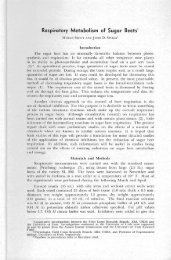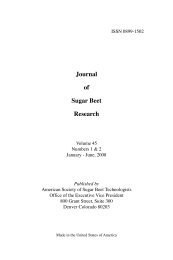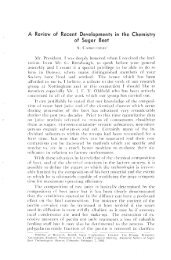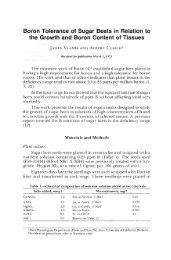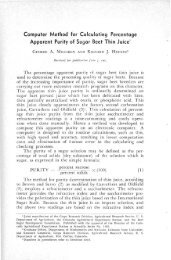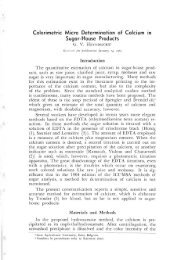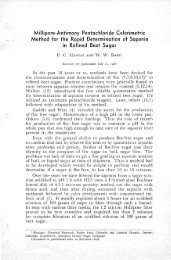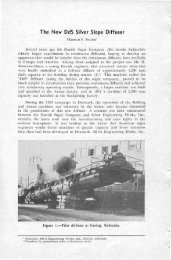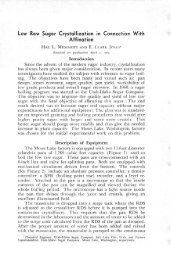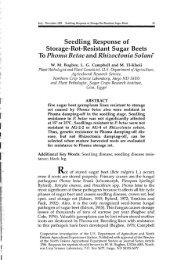Habit Modification of Sucrose Crystals A Lecture - Vol
Habit Modification of Sucrose Crystals A Lecture - Vol
Habit Modification of Sucrose Crystals A Lecture - Vol
Create successful ePaper yourself
Turn your PDF publications into a flip-book with our unique Google optimized e-Paper software.
VOL. 22, NO. I, APRIL 1983<br />
since 1966. This especially has served to focus attention<br />
on the subject and one <strong>of</strong> the purpose <strong>of</strong> the present dis<br />
course will be to mention what the writer considers some<br />
<strong>of</strong> the major unsolved problems in the field.<br />
At the factory level such matters are important be<br />
cause habit modifications frequently occur when growth<br />
rates are impeded by impurities; which same impurities may<br />
enhance viscosity with its problems. Altered shapes behave<br />
awkwardly in purging and packaging and such factors inter<br />
rupt normal smooth production and thus shape as well as<br />
size becomes important.<br />
CLASSIFICATION<br />
While most <strong>of</strong> the crystals in any particular strike<br />
may look alike, aside from differences in size, there are<br />
usually individuals which appear to differ in being dis<br />
proportinately elongated, thinner, etc. The properties <strong>of</strong><br />
such irregularities may differ considerably in repeated<br />
trials and when excessive create a problem for the sugar<br />
boiler. In addition he must be on the watch for conglome<br />
rates and twin formations as well as eroded and fragmented<br />
crystals. These are separate but related problems but<br />
will not be considered here. Neither will the formation<br />
<strong>of</strong> dendrites, spherulites, rosettes, etc. These are met<br />
more frequently in laboratory work and have been described<br />
in great detail by Powers (25) in a series <strong>of</strong> communica<br />
tions.<br />
Aside from this, Vavrinecz classifies single sucrose<br />
crystals morphologically as follows:<br />
A. Simple or normal <strong>of</strong> stout-prismatic form.<br />
B. Needles, elongated along the b-axis.<br />
C. Those elongated along C.<br />
D. Platelets on a, (100)<br />
E. on c, (001)<br />
F. on d, (101)<br />
G. on r, (101)<br />
H. Biphenods<br />
I. Triangles and pentangular shapes.<br />
Most <strong>of</strong> the examples illustrated in his Atlas were se<br />
61
VOL. 22, NO. I, APRI L 1983<br />
Like raffinose, dextran can be eliminated by selective<br />
enzymatic hydrolysis .<br />
111. Hexoses<br />
Oddly enough, the influence <strong>of</strong> hexoses and their com<br />
bination as invert on the crystallizing behavior <strong>of</strong> su<br />
crose has not been completely described in detail and much<br />
remains to be done on these important systems (25) .<br />
... Cry.tala DI••olved - 08y(8)<br />
!R8tflno••<br />
Number <strong>of</strong> Succ...ly. W••hlng. - Payne(33)<br />
Figure 4. Distribution <strong>of</strong> impurities through sucrose crystals.<br />
When growth is slow invert is effectively rejected by<br />
the growing crystal, as illustrated in Figure 4, but as<br />
higher temperature and supersaturation lead to faster<br />
growth more and more invert is contained within the<br />
growing crystal. This may be the result <strong>of</strong> being<br />
physically rather than chemically adsorbed but may equally<br />
well be the result <strong>of</strong> merely being trapped as inclusions<br />
rather than being truly adsorbed as might be expected from<br />
the chemical similarity <strong>of</strong> these moieties. However, the<br />
crystallographic dimensions <strong>of</strong> these several sugars (Table<br />
1 ) are so disparate that substitutional or epitactic<br />
growth would seem improbable in all these cases. On the<br />
other hand, the dimensions <strong>of</strong> these separate monosaccha<br />
rides are quite compatible with the moieties as they occur<br />
in the sucrose unit cell (5) . But again, on the same<br />
score, the uniform distribution <strong>of</strong> raffinose suggests its<br />
incorporation interstitually or a s-s solution in spite <strong>of</strong><br />
its high degree <strong>of</strong> disregistry. Why this is not so with<br />
the simpler monosaccharides is an enigma to the writer.<br />
Maybe calculations <strong>of</strong> intermolecular faces such as Michael<br />
Suska has been doing at LSU (27) may throw light on this<br />
question.<br />
At low concentrations and temperatures the effect <strong>of</strong><br />
67
68<br />
JOURNAL OF THE A.S.S.B.T.<br />
hexosis on habit is minimal but at higher levels (-<br />
200I/100W) and temperatures (60-70°) dextrose tends to<br />
favor plate like growth (especially under quiscent condi<br />
tions). Fructose, under these conditions definitely forms<br />
(1) triangles due to right end prism enlargement. At room<br />
temperature, and high glucose content, needles along c,<br />
Table 1. Crystallographic architecture <strong>of</strong> some sugars.<br />
Unit Cell, A<br />
a b c Z<br />
<strong>Sucrose</strong>-monoclinic 10.89 8.69 7.77 103 ° 2<br />
-D-glucose-anhydrous 10.36 14.69 4.97 90 ° 4<br />
orthorhombic<br />
"-monohydrate 8.72 5.03 9.59 97 ° 2<br />
monoclinic<br />
D-fructose 9.12 10.06 8.06 90 ° 4<br />
orthorhombic<br />
Raffino se 8.97 12.33 23.84 90 ° 4<br />
pentahydrate<br />
orthorhombic<br />
such as reported by McCleery (21), develop. These pat<br />
terns may very well be the result <strong>of</strong> the different orien<br />
tation <strong>of</strong> these moieties within the crystal. In the model<br />
Figure 5. <strong>Sucrose</strong> crystal - schematic.<br />
the dextrose component <strong>of</strong> sucrose lies essentially in the<br />
ab plane while the levulose half is approximately at right<br />
angles in the ac lane. If the corresponding faces advance<br />
by means <strong>of</strong> steps on these planes we would then expect<br />
dextrose impurity if adsorbed to impede extension in the a<br />
direction, with enlargement <strong>of</strong> this face, and levulose<br />
likewise regarding the c face (Figure 5). These are<br />
exactly the habit modifications observed when these im<br />
purities are present in the mother liquor although con<br />
siderable amounts are needed to bring out marked changes.
VOL. 22, NO. I, APRIL 1983<br />
It also seems not unlikely that this orientation may<br />
have something to do with the pronounced difference in<br />
ratios <strong>of</strong> advance <strong>of</strong> the right and left poles. This seems<br />
to be aggravated especially by the presence <strong>of</strong> fructose<br />
which overall appears to have more effect than glucose (9,<br />
29) •<br />
High invert and corn syrups as well as honey are<br />
usually reluctant to crystallize even when seeded. If,<br />
however, the sucrose content is increased by saturation at<br />
a higher temperature they will then throw down all sorts<br />
<strong>of</strong> sucrose crystals including needles, blades, triangles,<br />
etc. Figure 6 is just one illustration <strong>of</strong> this unusual<br />
combination <strong>of</strong> triangles and elongated crystals caused<br />
from a fortified dark colored corn syrup. No doubt, the<br />
synergistic behavior referred to in Part II is operating<br />
here.<br />
Figure 6. Triangles and elongated sucrose crystals deposited<br />
simultaneously from a fortified corn syrup.<br />
Invert sugar is much more common in cane juices than<br />
beet and many attempts to avoid arid reduce it, as well as<br />
utilize it for desugarizing molasses, have been proposed.<br />
However, I must confess I am unacquainted with the prob<br />
lem.<br />
IV. Lactic Acid<br />
I was recently asked if lactic acid had any special<br />
habit modifying effects. Not finding any reference to<br />
this substance in the voluminous literature on the subject<br />
I tried it out at a concentration <strong>of</strong> 1M., sodium lactate,<br />
which is about 3 times the extreme that may be expected.<br />
Nothing unusual was observed in the crop <strong>of</strong> crystals ob<br />
tained. Neither did its addition to a cane molasses on<br />
hand exert any influence so, presumably, no synergistic<br />
69
72 JOURNAL OF THE A.S.S.B.T.<br />
(26) Robinson, D. J., 1969. <strong>Sucrose</strong> <strong>Crystals</strong> from<br />
Dextran Containing Syrups. Ph.D. Thesis, U.<br />
Queensland.<br />
(27) Saska, M., 1982. Private communication.<br />
(28) Saska, M. and Polack, J., 1982. Proc. Cane Sugar<br />
Ref. Res., Atlanta.<br />
(29) Schneider, F., Emmerick, A., and Akyar, D. C., 1975.<br />
Occulusion <strong>of</strong> Non-<strong>Sucrose</strong> Substances during<br />
Crystallization <strong>of</strong> <strong>Sucrose</strong>. Zucker 28(3) 113.<br />
(30) Smythe, B. M., 1971. <strong>Sucrose</strong> Crystal Growth.<br />
Austral. J. Chern. 20 1087-1131; Sugar Tech. Rev.<br />
191.<br />
(31) VanHook, A., 1967. Sugar Crystallization. C.I.T.S.<br />
XIII Session, Falsterbo, p. 38.<br />
(32) VanHook, A., 1981. <strong>Habit</strong> <strong>Modification</strong> <strong>of</strong> <strong>Sucrose</strong><br />
<strong>Crystals</strong>. J. Am. Soc. Sugar Beet Technol.<br />
21(2): 131.<br />
(33) VanHook, A., 1976. Some nNotes on <strong>Sucrose</strong><br />
Crystallized from Syrups Containing Raffinose.<br />
Proc. Res. Soc. Japan Sugar Ref. Tech. 26 74.<br />
(34) VanHook, A., 1968. Influence <strong>of</strong> Adsorbed impurities<br />
in Growth Rate and <strong>Habit</strong> <strong>of</strong> <strong>Sucrose</strong> <strong>Crystals</strong>, <strong>Vol</strong>.<br />
8. Growth <strong>of</strong> <strong>Crystals</strong> ed. by N. N. Sheftal,<br />
Consultants Bureau, NY p. 38.<br />
(35) VanHook, A., 1982. Influence <strong>of</strong> Hexoses on Sugar<br />
Crystallization. A lecture, U. Ferrara. Ind. Sacco<br />
Ital (75) 96.<br />
(36) VanHook, A. and Brown, J., 1972. The Forms <strong>of</strong><br />
<strong>Sucrose</strong> <strong>Crystals</strong> (IV). Inc. Sacc. Ital. (2) 46.<br />
(37) Vavrinecz, G., 1965. Atlas <strong>of</strong> Sugar Cryst-als, A.<br />
Bartens, Berlin.



